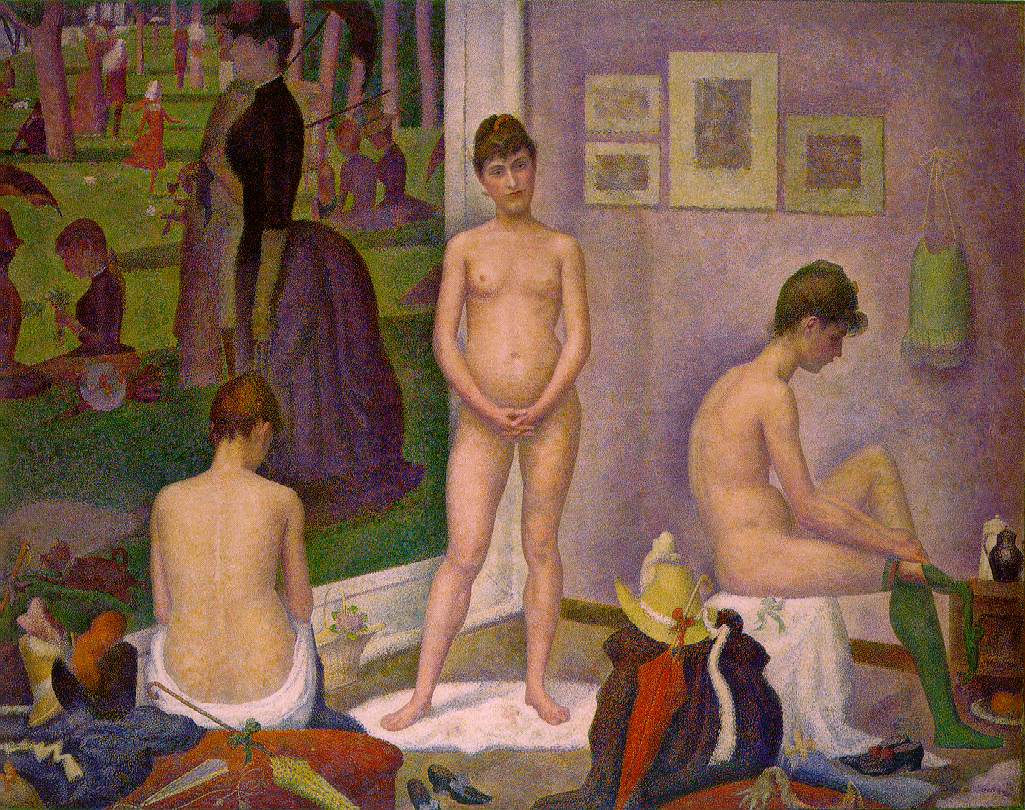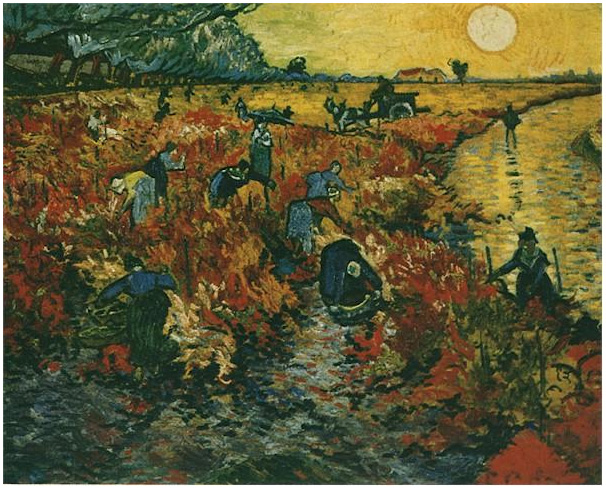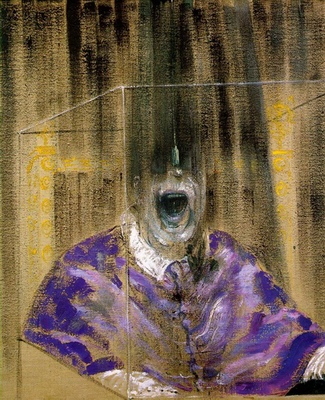
Monday, January 31, 2011
Apple Tree with Red Fruit

Mont Sainte-Victoire

Wednesday, January 26, 2011

 This oil on canvas painting titled "The Artist's Garden at Giverny" was created by Claude Monet (1840-1926) in 1900. This is a picture of his gardens at his home in Giverny, France. It was said that his garderns were a source of inspiration for him as well as many other artists to this very day. While looking through images on Google, this one really jumped out at me. It is a very soft picture that reminds me of the springtime, my favorite time of year. The picture gives me a feeling of warmth and calmness, just as if you were on that path walking through the purple flowers.
This oil on canvas painting titled "The Artist's Garden at Giverny" was created by Claude Monet (1840-1926) in 1900. This is a picture of his gardens at his home in Giverny, France. It was said that his garderns were a source of inspiration for him as well as many other artists to this very day. While looking through images on Google, this one really jumped out at me. It is a very soft picture that reminds me of the springtime, my favorite time of year. The picture gives me a feeling of warmth and calmness, just as if you were on that path walking through the purple flowers.Setting Sun

Chiura Obata (1885–1975) painted the Setting Sun which is of the Sacramento Valley, California, in 1925. It is a Hanging scroll made with mineral pigments (distemper) and gold on silk. I found this painting through Google on some website about Asian-American modern art and thought that it was really cool. The sky looks like it is on fire but still has that tropical blue sunset sky behind it. It reminds me of sunsets in Ibiza, where went this past summer.
The Cafe Concert
 "The Cafe Concert" was painted by Edouard Manet in 1878 and he used oil on canvas. Manet painted a few different cafe scenes trying to describe observations of social life in 19th century Paris. People in the painting are depicted drinking, listening to music, reading, or being waited on. Apart from the man with the black top hat, each person in this painting is either cut in half because of the frame or is overlapped by another person. It seems as though the man with the top hat is supposed to be our main focus in this painting, but in fact, I find the room itself to be the main focus. I find this painting very interesting but also a little complex.
"The Cafe Concert" was painted by Edouard Manet in 1878 and he used oil on canvas. Manet painted a few different cafe scenes trying to describe observations of social life in 19th century Paris. People in the painting are depicted drinking, listening to music, reading, or being waited on. Apart from the man with the black top hat, each person in this painting is either cut in half because of the frame or is overlapped by another person. It seems as though the man with the top hat is supposed to be our main focus in this painting, but in fact, I find the room itself to be the main focus. I find this painting very interesting but also a little complex.Les Poseuses by Georges Seurat

Dance Class

The Oath of Horatii
Tuesday, January 25, 2011
Mercury passing before the sun
 "The Mercury passing before the sun as seen through a telescope" is one of Giacomo Balla's beautiful paintings. The artist uses a set of primary and secondary colors associated with a combination of bright complementary colors such as blue and orange. The application of tempera on paper gives the painting a nice texture especially with the different layers of paint, one on top of each other to create the different shapes (some organic, some geometric) and the use of black and white for light and shadow. The subject in the artwork doesn't seem like it could be easily or clearly be identified; I have never seen mercury passing before the sun through a telescope before, but the artist could have portrayed mercury the way he had perceived it artistically.
"The Mercury passing before the sun as seen through a telescope" is one of Giacomo Balla's beautiful paintings. The artist uses a set of primary and secondary colors associated with a combination of bright complementary colors such as blue and orange. The application of tempera on paper gives the painting a nice texture especially with the different layers of paint, one on top of each other to create the different shapes (some organic, some geometric) and the use of black and white for light and shadow. The subject in the artwork doesn't seem like it could be easily or clearly be identified; I have never seen mercury passing before the sun through a telescope before, but the artist could have portrayed mercury the way he had perceived it artistically.
The Red Vineyard

The Red Vineyard by Vincent Van Gogh was painted in November of 1888 on oil on canvas. This painting is an extremely significant piece because it was supposedly the only piece of Van Gogh's that was sold while he was alive. The painting shows the hardships of workers harvesting crops under the bright sunlight. It is a historical representation of life on European vineyards. I also think that the painting may be expressing the issue of slavery. It is apparent that the people who are bending over and working in the fields are being supervised by others who posses fine carriages and appear to be dressed much more fashionably.
The Child's Bath- Mary Cassatt
Ballet Probe

This painting is Ballettprobe by Edgar Degas. it was an oil on canvas painting done in 1873. Degas is one of the most popular impressionist painters who was very outspoken about the needs of artists and their lifestyles. He organized what is now known as the first Impressionist exhibition and planned many of the subsequent shows. He initially called himself and his compatriots "realists," which pointed to their interest in drawing inspiration from their own environments and experiences. the reason i chose this painting was because i loved the dancers. although the painting seems a little blurry, the colors blend beautifully and you can still clearly see the picture. it also shows depth perception. the dancers in the front are larger than the ones in the back, and the musician in the front are even larger than all the dancers. i especially like the way the light is portrayed coming in from the windows. it allows light to be shed on the main focus of the painting, the dancers.

This painting is named "Luncheon on the grass" by Edward Manet. It was painted in 1863 using the medium oil on canvas. To be honest I didn't really like this painting. I find it weird that the women is just sitting there naked while the men are fully clothed. I know at that time a painting like this was considered very scandalous and thus intriguing. I however do not like it. I don't understand why a women would be picnicking naked with two men. I also do not like the look she is giving the viewers. It just gives me an uncomfortable feeling. I don't understand the women in the background either. It is believed that she is bathing, but why would someone do that at lunch. I just really don't understand it.
HE/SHE

He/She by Tim Noble and Sue Webster, is one of my favorite works of art. Though it is not a Modernism work of art, it is a work of art all the same. The medium is a mixture of welded metals into what looks like a deformed creation but when light is hit by it the shadows displayed on the wall are what the welded metal appear to be! Isn't it amazing?! I just absolutely love the way something that looks like trash can actually look like a real human being peeing! To me this is a true work of art. It keeps that saying alive: "that one persons trash, can be another persons treasure!" Though I would not display something like this in my house I just love the image that this came out to be. The artists Noble and Webster, did a series of different materials, one actually being trash! I encourage you to look into their artwork because the texture of their work turns into something oh so amazing! :)
Boulevard de Capucines by Claude Monet

Boulevard de Capucines was created by Claude Monet in 1873. The painting, which was done in oil paint on canvas exhibits the use of loose brush strokes which is commonly identified as a key element of painting during the impressionist movement. What fascinates me the most about this painting, and impressionism in general, is the ability to create an identifiable image without having to paint with significant detail. Particularly, in Boulevard de Capucines, the subject of the people on the snowy street don't truly or accurately resemble a detailed human figure, it's simply just a few brush strokes, but it still manages to successfully portray a crowded street full of people.
The Flaming Core of Love and Rage

The Scream
 The Scream is by Edvard Munch created in 1893. It is oil, tempera and pastel on canvas. The reason that I liked this painting was because I thought it showed a true sense of human emotion. The figure in the painting seems to be screaming with agony. When people are truely that upset, it may seem that nothing else around them matters. I feel that he uses the blood red sky and the undistinguished lines to show that everything around this figure was becoming blurry. It seems almost as if the figure itself is blending into nature, that they are becoming one. To me this painting is the perfect example of how human emotions can control ones life and make things seem almost unreal at times.
The Scream is by Edvard Munch created in 1893. It is oil, tempera and pastel on canvas. The reason that I liked this painting was because I thought it showed a true sense of human emotion. The figure in the painting seems to be screaming with agony. When people are truely that upset, it may seem that nothing else around them matters. I feel that he uses the blood red sky and the undistinguished lines to show that everything around this figure was becoming blurry. It seems almost as if the figure itself is blending into nature, that they are becoming one. To me this painting is the perfect example of how human emotions can control ones life and make things seem almost unreal at times.Monday, January 24, 2011
Impression Sunrise 1872

Claude Monet was an artist in the Impressionist movement, which was the first movement in the Modern Art era. An artist Louis Leroy critiqued this painting and came up with the word "Impressionism". Impressionism was a style of painting that used color to enhance light in nature. As you can see in this painting, Monet used brighter colors to show light in the landscape. You are able to see short brush strokes, which was also a style used in impressionism. Most impressionists painted landscapes like this one, and they had to be painted in a timely fashion in order to capture the light in time. This is also why impressionist paintings look not so detailed because artists couldn't take the time to use accurate line and detail. Monet did a great job using color, and space in this landscape to capture light and nature.
Paul Serusier. The Talisman

Temptation and Fall

Head VI

Francis Bacon - "Head VI" (1949) Oil on canvas
Tuesday, January 18, 2011
Enjoying Modern Art 2011
 |
| "After Cole" 2010 Gary Jacketti |
